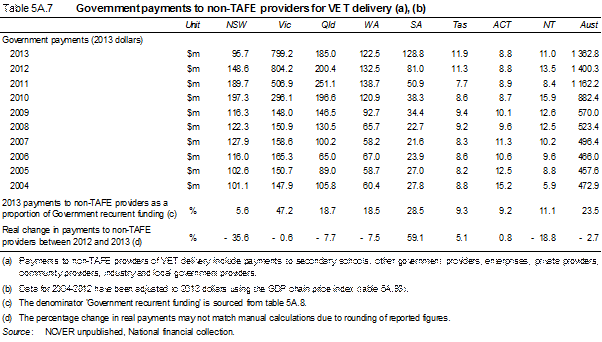Interim report: the operation, regulation and funding of private vocational education and training (VET) providers in Australia
2 March 2015
© Commonwealth of Australia 2015
View the report as a single document - (PDF 94KB)
Referral
1.1
On 24 November 2014 the Senate referred the following matter to the
Education and Employment References Committee (committee) for inquiry and
report by 10 August 2015:
The operation, regulation and funding of private vocational
education and training (VET) providers in Australia, including:
- the access private VET providers have to
Commonwealth and state public funding,
- the cost of education at private VET providers,
- the regulatory regime private VET providers operate
within,
- the operation of VET-FEE-HELP,
- the quality of education provided by private VET
providers, volume of learning requirements and graduate outcomes,
- marketing and promotional techniques employed by
private VET providers and education brokers both domestic and international,
- any incidents or allegations of non-compliance with
regulation and funding arrangements at private VET providers,
- political donations made by private VET providers,
- international comparisons to the Australian funding
and regulatory regime,
- the operation, regulation and funding of private VET
providers specifically offering courses in aged care and early childhood
education and their labour market outcomes, and
- any related matters.[1]
1.2
The committee presents this interim report to the Senate on 2 March 2015
and intends to present their second interim report by 15 June 2015.[2]
The context of this inquiry
1.3
In April 2012 the Council of Australian Governments (COAG) agreed to a
revised National Agreement for Skills and Workforce Development and a new National
Partnership Agreement on Skills Reform.[3]
1.4
At the heart of these reforms was the adoption of the Commonwealth
proposal for a national training entitlement, the increased availability of
income contingent loans, and a more open and competitive vocational and
educational training (VET) market.[4]
1.5
As of July 2014, VET providers in all states and territories, excluding
ACT, have access to the income contingent loan scheme VET-FEE HELP.[5]
1.6
Since the introduction of these reforms the profile of VET provision in
Australia has changed significantly,[6]
and as such, this inquiry aims to provide some perspective on the impacts of
these changes, with a specific focus on private providers.
Increased government funding to
non-TAFE providers for VET delivery
1.7
The committee is concerned about the rapid increase in government
funding to non-TAFE providers since the implementation of the market-driven
funding model for VET. Specifically, the committee notes that government
payments to non-TAFE providers for VET delivery was $523.4 million in 2008,
compared to $1362.8 million in 2013.
Figure 1 – Government payments to non-TAFE providers
for VET delivery 2004 – 2013

Australian Government, Productivity Commission, Vocational
education and training, 2013, Attachments, Table 5A.7.
The volume of VET FEE-HELP
1.8
The committee is also concerned about the increased volume in VET
FEE-HELP funding to for-profit VET providers who retain a substantial amount of
the loan as profit. The committee notes, Sydney University Research, commissioned
by the Australian Education Union, claiming that in 2014 the VET-FEE funding to
for-profit providers was $592.6 million compared with $177.5 million for
state-administered TAFE institutes.[7]
1.9
In a submission to this inquiry, the Australian Council for Private
Education and Training (ACPET) argues that 'VET FEE-HELP has created greater
choice for students, and created real opportunities for students who would not
have had the opportunity without the program'.[8]
1.10
In taking into consideration this increased volume in a deregulated fee
environment market, the committee is particularly interested in exploring
through this inquiry the economic and social costs and benefits associated with
for-profit diploma and advanced diploma qualifications.
1.11
The committee is also concerned by evidence suggesting that 40 per cent
of all VET FEE-HELP loans will not be repaid due to lack of job opportunities
for VET graduates and low wages.[9]
Such a high level of bad debt in effect functions as an additional subsidy to
providers as the cost is borne by the taxpayer.
Marketing techniques used by
private providers
1.12
The committee has received a number of submissions that highlight
concerning reports of aggressive marketing techniques used by private education
companies and education brokers.
1.13
The committee is concerned about the link between access to government
funding and a subsequent increase in targeted marketing, particularly that
which
de-emphasises the real cost of undertaking VET and misconstrues the costs
associated with VET FEE-HELP.
The current regulatory arrangements
1.14
Qualifications achieved through the VET system are governed by the
Australian Qualifications Framework (AQF) and this system is regulated by the
Australian Skills Quality Authority (ASQA).[10]
In order for a VET training provider to become a Registered Training Provider
(RTO) they must meet the national compliance Standards and Essential Conditions
contained in the Australian Quality Training Framework (AQTF). Currently,
states and territories have separate bodies to regulate these standards.[11]
1.15
The committee notes that an appropriate regulatory environment is key to
ensuring consistent high quality standards of training and skills development
in a competitive market. The committee is concerned that the current regulatory
framework is not as effective as it can be. In exploring the regulation of VET
in Australia the committee hopes to focus on the quality of private VET
provision, the competence of graduates, the recruitment of students and regulatory
enforcement.
Conduct of the inquiry
Submissions
1.16
The committee called for submissions by 13 February 2015. To date, it
has received 50 submissions, the majority of which were made by VET service
providers and trainers, peak stakeholder organisations and students. The
committee thanks all those individuals and organisations who made a submission
to this inquiry.
Additional consultation
1.17
The committee intends to hold public hearings in various places
throughout Australia.
Senator Sue
Lines
Chair